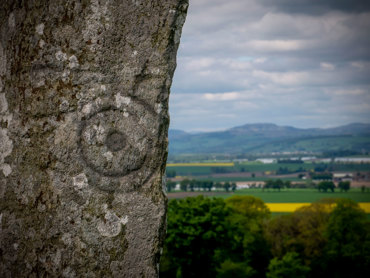Our Heritage Timeline
Picts & Pictish Stones

Photo courtesy of Graeme Berry
Article Details
- Date:
- c300 - c900 AD(CE) Picts & Pictish Stones
Categories
Picts & Pictish Stones
What remains of the original kings of Scotland?
Video courtesy of Graeme Berry/Isla Aerial Surveying & Imaging
The Picts were a confederation of Celtic-speaking people who lived in eastern and northern Scotland during the late Iron Age and Early Medieval periods. They came together to oppose the Romans. The name Pict comes from ‘picti,’ a Latin word meaning ‘painted people.’
Today the Picts are renowned for their elaborate carvings on stones, around 350 of which have survived. There were several Pictish power centres in Perthshire.
MEIGLE, which lies just over 8 miles from Blairgowrie, was a Pictish centre of some importance, and one of the largest collections of Pictish stones may be seen in the Meigle Pictish Stone Museum.
FORTEVIOT, around 23 miles south of Blairgowrie, was a Pictish centre of great importance. Kenneth MacAlpin, King of the Picts, is said to have died in the palace which stood on Haly Hill, on the west side of the modern village, overlooking the Water of May.
KING’S SEAT HILLFORT, DUNKELD, around 12 miles from Blairgowrie, was recently excavated by Perth and Kinross Heritage Trust. Evidence was uncovered of a powerful Pictish society. The site is believed to have been a stronghold of high status people, the elite of the local population.
For further information watch King’s Seat Hillfort Archaeology Project – Perth and Kinross Heritage Trust: https://pkht.org.uk/projects/current-projects/kings-seat
Other Iron Age Hillforts in Perthshire include DUNDURN (near St Fillan’s), DUNSINANE and MONCREIFFE HILL.
A five year excavation project led by Perth and Kinross Heritage Trust at LAIR in GLENSHEE has given an insight into the everyday lives of ordinary Pictish people. Living in a settlement of longhouses were farming people, skilled metal workers and textile makers.
For more information and a Virtual Reality Tour of the Lair longhouses visit https://pkht.org.uk/projects/completed-projects/glenshee
PICTISH STONES
One of the largest collections of Pictish stones may be seen at THE MEIGLE PICTISH STONE MUSEUM (see map below). One of the most impressive stands 2.5m high and shows figures on horseback at the top, and mythical beasts at the bottom. Some believe the scene in the centre depicts Daniel in the lions’ den, and others that it shows the execution of Vanora, or Queen Guinevere of Arthurian legend.
Video credit - Graeme Berry/Isla Aerial Surveying & Imaging
Other Pictish stones in Perthshire and surrounding area include:
The Alyth Stone (in the porch of the church)
The Keillor Stone (between Kettins and Newtyle)
The Dunfallandy Stone near Pitlochry
The Struan Stone near Blair Atholl
The St Madoes Stone (in St Madoes Churchyard)
The Dupplin Cross Stone (in St Serf’s Church, Dunning)
The Kettins Cross Slab (in Kettins Churchyard)
Here is a map of local Pictish Stones
For more information see YouTube videos:
Picts: Part 1 Symbols and Signs by Dip in Video
Picts: Part 2 Symbols and Statements by Dip in Video
Picts: History and Heritage by Dip in Video
Previous Page
